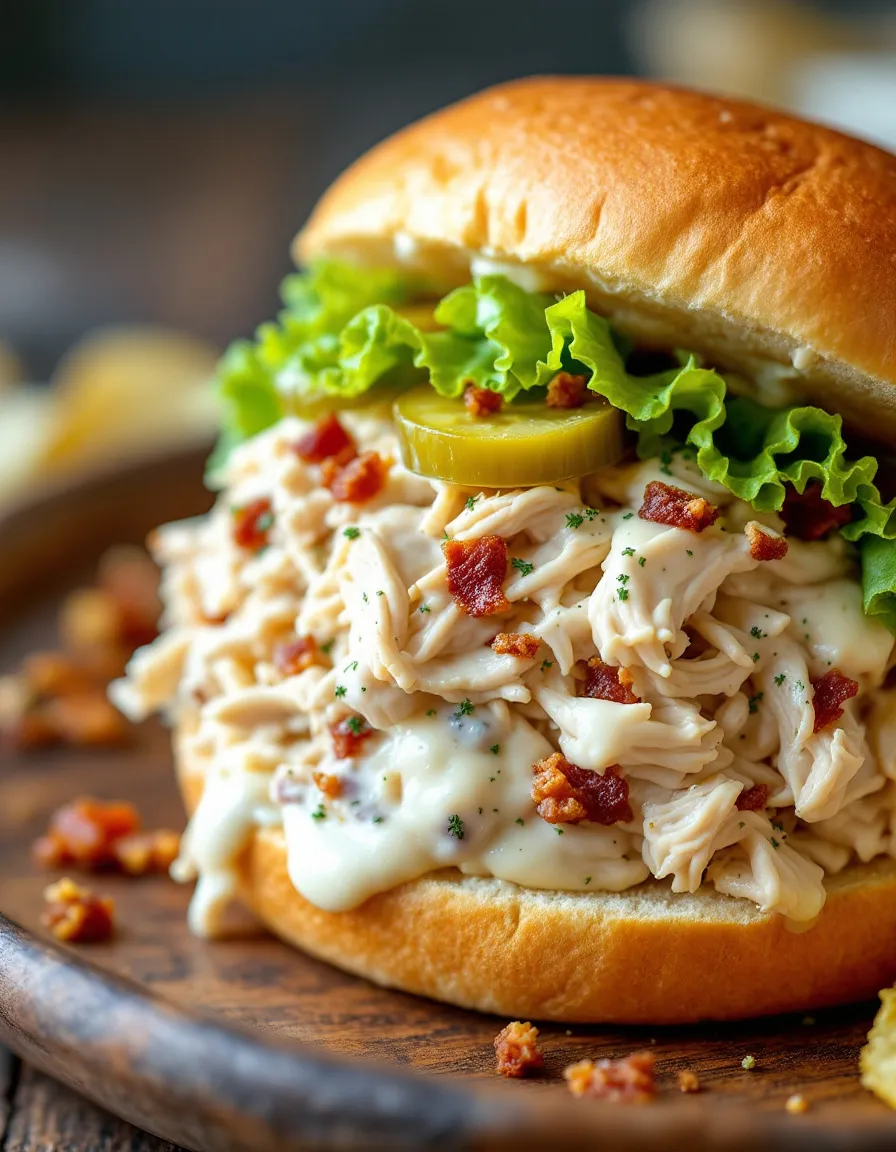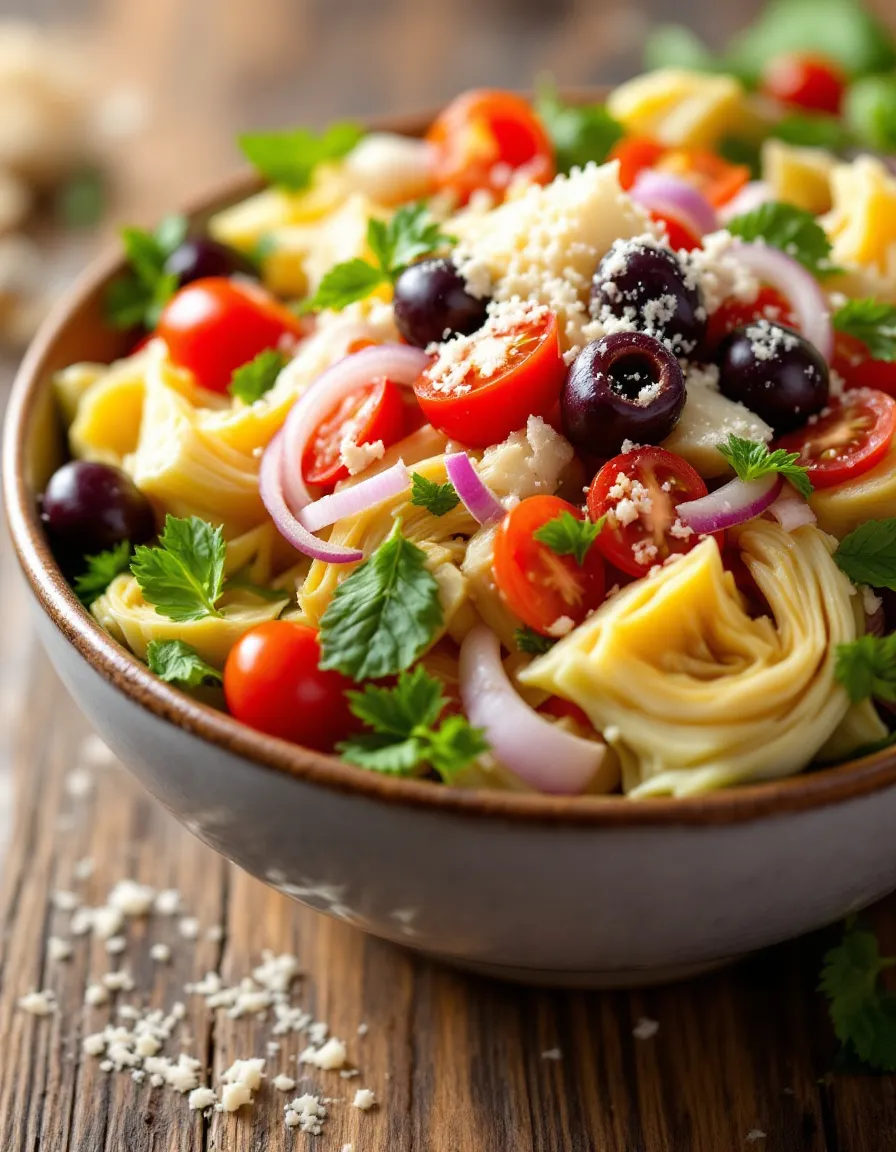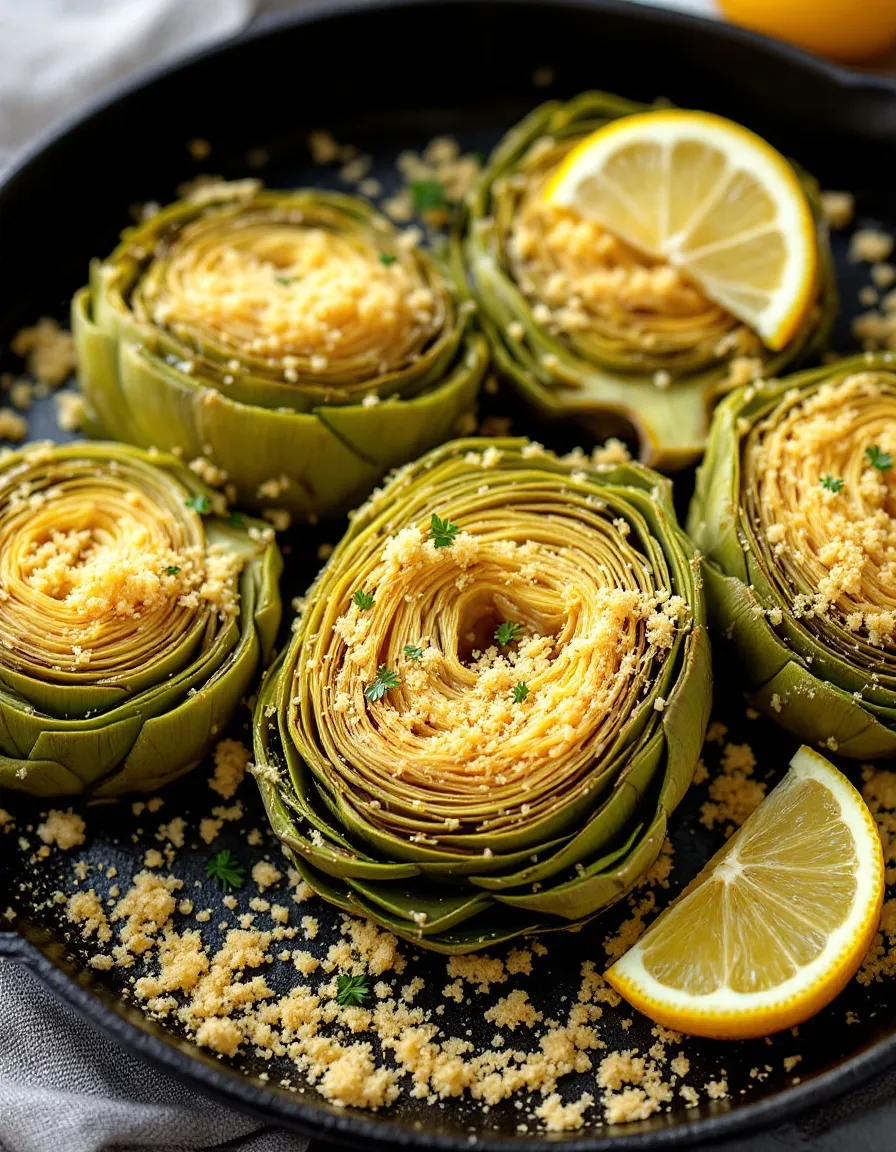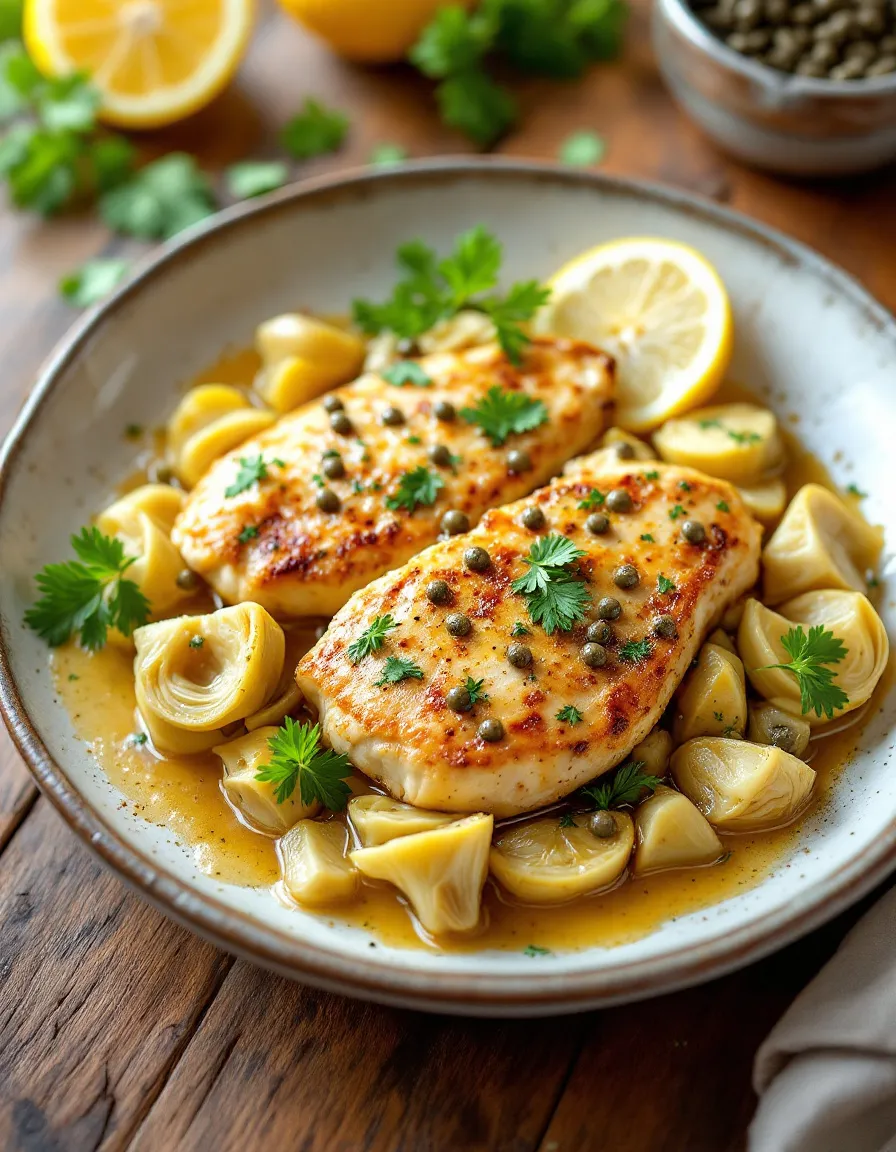Pasta with Artichoke Sauce: A Creamy Delight for Every Occasion
Pasta with Artichoke Sauce is a creamy, flavorful dish that brightens any table. This easy-to-make recipe combines the delightful flavors of tender pasta with a rich, velvety sauce made from artichokes, garlic, and a hint of lemon. The combination creates a breathtaking meal that’s perfect for weeknight dinners or special occasions. The artichokes bring an earthy, slightly nutty flavor that pairs beautifully with al dente pasta, ensuring every bite is utterly satisfying.
The comforting aroma of sautéed garlic and artichokes fills your kitchen as you prepare this dish, making it an enticing option for family or guests. Visual appeal is essential in any recipe, and this pasta dish does not disappoint; the creamy sauce clings to the noodles, creating a luscious appearance that’s topped with a sprinkle of freshly grated Parmesan cheese and a burst of vibrant herbs. This dish is sure to impress, offering a wonderful taste experience while being simple enough for any home cook to conquer.
Quick Recipe Highlights
- Flavor Profile: The artichoke sauce is creamy with hints of garlic and lemon, providing a perfect balance of richness and zest.
- Texture: Creamy and smooth, the sauce envelops the pasta while the artichokes add a delightful bite, making each mouthful interesting.
- Aroma: The combination of sautéed garlic and artichokes gives this dish a warm and inviting smell that appeals to everyone.
- Visual Appeal: The light beige of the sauce against the golden pasta creates an appetizing dish garnished with green herbs.
- Skill Level Needed: This recipe is easy to master, making it perfect for both novice and experienced cooks.
- Special Equipment: No special tools are required; simply a pot for boiling pasta and a pan for making the sauce.
Recipe Overview
- Difficulty Level: This pasta dish is classified as easy, making it suitable for beginners who are learning to navigate the kitchen.
- Category: Perfect for a main course, it can also serve as a side dish for grilled meats or vegetables.
- Cuisine: This dish is inspired by Mediterranean flavors, reflecting a rich culinary tradition centered on fresh ingredients.
- Cost: With accessible ingredients, this recipe is budget-friendly, averaging around $10 to serve four people.
- Season: Although delightful any time of year, it shines best in spring and early summer when artichokes are at their peak.
- Occasion: Serve it for family dinners, entertaining friends, or even as a quick weeknight meal everyone will love.
Why You’ll Love This Recipe
The taste and texture of Pasta with Artichoke Sauce work in harmony to create a dish that delights the palate. The creaminess of the sauce is perfectly complemented by the tender artichokes, which offer a pleasing bite, making each forkful satisfying. The subtle lemon brightness cuts through the richness, ensuring this dish doesn’t become overly heavy. With a sprinkle of cheese on top, every person at the table will savor the explosion of flavors.
Convenience plays a significant role in the charm of this recipe. With just a handful of ingredients and minimal preparation time, you can whip up this delectable meal in no time. It’s an excellent choice for weeknight dinners when you want something that tastes gourmet but doesn’t require hours in the kitchen. Plus, the creamy consistency of the sauce clings beautifully to the pasta, ensuring every bite is filled with flavor.
Nutritionally, artichokes are a powerhouse of health benefits, being low in calories and high in fiber, vitamins, and antioxidants. This dish allows you to indulge in a delightful meal while still focusing on nutrition. The heart of the artichoke is full of nutrients that contribute to your overall health, making this recipe not just delicious but beneficial as well.
Pasta with Artichoke Sauce also holds social value, whether you’re hosting a dinner party or enjoying a meal with family. It’s a crowd-pleaser that brings people together around the table. Pair it with a crisp salad and a good bottle of wine, and you have a perfect evening that invites conversation and connection.
Finally, the accessibility of this recipe ensures that deliciousness doesn’t come with an extravagant price tag. Most ingredients can be found at your local grocery store without breaking the bank, making it an ideal choice for anyone looking for a simple yet satisfying meal that won’t stretch their budget.
Historical Background and Cultural Significance
The origins of artichoke sauce can be traced back to Mediterranean cuisine, where artichokes were cultivated for centuries. These unique vegetables were favored not only for their flavor but also for their health benefits. Their presence in Italian kitchens particularly has paved the way for delicious recipes, including the renowned pasta dishes found throughout the region.
Culturally, artichokes represent a symbol of fine dining in many Mediterranean countries. They were historically enjoyed by royalty and remain a delicacy today. The celebration of fresh produce in these recipes reflects a broader philosophy that values seasonal ingredients and culinary traditions passed down through generations.
As time has progressed, recipes using artichokes have evolved, adapting to incorporate various cooking styles and flavors. This adaptability allows cooks around the world to experiment with ingredients and presentation, resulting in countless variations of pasta with artichoke sauce that preserve their delightful essence while embracing modernization.
Regionally, different countries have their takes on artichoke dishes. In Italy, they often highlight simplicity, letting the natural flavors shine, while in other Mediterranean cuisines, you may find them paired with bold spices and rich sauces, showcasing the versatility of this prized vegetable.
Ingredient Deep Dive
For a star ingredient like artichokes, understanding their cultural significance is key. Originating in the Mediterranean, artichokes have been cultivated for thousands of years. They’re revered not only for their unique flavor but also for their historical use in medicinal remedies. Their high antioxidant content has made them a popular choice for health-conscious cooks.
Nutritionally, artichokes are low in calories yet high in fiber, making them ideal for digestive health. They are also a good source of vitamins C and K, and minerals like magnesium. When selecting artichokes, look for firm, tightly packed buds with vibrant coloring. Store them in a cool, dry place and consume within a few days for optimal freshness. If you’re unable to find fresh artichokes, canned or frozen options work well in this recipe.
Garlic, an essential ingredient in this pasta dish, holds a special place in culinary history. Native to Central Asia, it has been used for millennia, both as a flavor enhancer and for its purported health benefits. Rich in antioxidants and known for its anti-inflammatory properties, garlic brings both a savory punch and numerous health benefits.
When picking garlic, choose firm bulbs without soft spots or signs of sprouting. Store in a dark, cool place for up to three months. A popular substitution for garlic includes garlic powder or shallots, though fresh garlic will yield the best flavor.
Cream, another key ingredient, adds richness and a velvety texture to the sauce. While it’s not a historical staple in all cuisines, it’s widely used in Italian cooking to achieve creamy sauces that pair beautifully with pasta. Fresh cream is best, but substitutes like yogurt can be used for a lighter alternative, yielding a similar texture.
Common Mistakes to Avoid
- Overcooking the pasta: Aim for al dente; cooking it too long can lead to mushy texture.
- Not seasoning the pasta water: Ensure it’s well-salted to enhance flavor before the pasta is added.
- Using too much or too little cream: Balance is key; use enough to create a creamy sauce without overpowering the dish.
- Neglecting to drain artichokes properly: Excess water can dilute the sauce’s flavor and consistency.
- Skipping the sautéing step for garlic: Raw garlic can be harsh; sautéing brings out its sweet, rich flavor.
- Not using fresh herbs: Fresh herbs significantly elevate the dish’s flavor compared to dried counterparts.
- Rushing through the sauce preparation: Allow the ingredients to meld properly; a quick cook can result in lackluster flavors.
- Underestimating the importance of presentation: Take time to plate the dish attractively; it enhances the dining experience.
- Storing leftovers improperly: These can spoil quickly; ensure you refrigerate them within two hours.
- Overlooking the balance of flavors: Adjust seasoning as you cook to achieve a well-rounded taste profile.
Essential Techniques
To achieve the perfect al dente pasta, start with a large pot of salted water and bring it to a boil before adding your pasta. Stir occasionally to prevent sticking. Test for doneness a minute before the package directions indicate to avoid overcooking. This technique is crucial for ensuring that the pasta holds its shape and texture, providing a pleasant contrast to the creamy sauce.
For a velvety sauce, mastering the sautéing technique is essential. Start with a preheated pan and add your garlic, allowing it to infuse the oil before adding the artichokes. Stirring frequently prevents burning and allows the ingredients to develop a deep, rich flavor. Visual cues such as golden-brown garlic pieces signal that it’s time to move forward with the recipe, ensuring your sauce is aromatic and flavorful.
Pro Tips for Perfect Pasta with Artichoke Sauce
When preparing Pasta with Artichoke Sauce, always remember to use high-quality ingredients. Fresh pasta is ideal; however, dried pasta can work beautifully if cooked correctly. Opt for artisan pasta brands for authentic flavors and textures that complement the dish well.
Don’t shy away from experimenting with additional flavors. Incorporate a splash of white wine after sautéing the garlic to heighten the sauce’s depth. Following a simmer, allow the alcohol to evaporate, leaving behind a rich flavor profile that harmonizes beautifully with the artichokes.
Enhance the dish’s presentation using fresh herbs such as parsley or basil. A sprinkle on top before serving brings a fresh aroma and a visual pop, transforming a simple dish into something appealing and vibrant.
Use freshly grated cheese rather than pre-shredded versions, as they often contain anti-caking agents that can dull flavor. Fresh cheese melts seamlessly into the sauce, ensuring each bite is decadent.
Make the dish your own by adding extra veggies or proteins. Spinach, sun-dried tomatoes, or grilled chicken can add color and taste while increasing the nutritional value of the dish.
Lastly, be mindful of the sauce’s consistency; if it seems too thick, a splash of pasta cooking water can loosen it without losing flavor. This simple adjustment helps achieve a creamy, cohesive sauce that clings beautifully to the pasta.
Variations and Adaptations
There are numerous ways to adapt Pasta with Artichoke Sauce to fit different tastes and preferences. For a regional twist, consider adding Italian sausage or cherry tomatoes for a robust flavor. Alternatively, a Mediterranean flair can be achieved by including olives and feta cheese, enhancing the dish’s authenticity.
Seasonal adaptations include using fresh asparagus in the spring or zucchini in the summer, both of which complement artichokes beautifully. These fresh additions add texture, brightness, and nutritional value to the dish.
For those with dietary restrictions, there are plenty of modifications available. A gluten-free version can be created using gluten-free pasta while maintaining the traditional sauce. Vegan adaptations can easily replace cream with coconut milk or cashew cream, providing a creamy base that aligns with plant-based diets.
Flavor variations can enhance your experience as well. Incorporate spicy red pepper flakes for heat or add a drizzle of balsamic glaze for a sweet-tangy finish. Adjusting the flavor profile can create a new and exciting dish each time.
Consider variations in texture by opting for a baked version of the dish, adding a crunchy topping of breadcrumbs mixed with herbs and cheese. Baking brings a different dimension to the sauce and pasta, creating delightful layers and textures.
Lastly, presentation can be adapted by serving the pasta in a hollowed-out bread bowl or in stackable layers, a more refined approach that emphasizes the dish’s elegance while providing an enticing visual experience.
Serving and Presentation Guide
Plating techniques greatly enhance the dining experience, starting with how you serve the pasta. Consider twirling the pasta onto individual plates for a visually appealing presentation, allowing the creamy sauce to cascade over each serving.
Garnishing plays a significant role in making the dish pop. Freshly chopped herbs like parsley or basil not only provide vibrant color but also a fresh aroma. A sprinkle of freshly grated Parmesan cheese adds sophistication, while crushed red pepper flakes can introduce a delightful dash of color and heat.
Traditional accompaniments like garlic bread or a simple green salad pair wonderfully with this dish, complementing its creamy richness. Modern serving suggestions include pairing with a light white wine to enhance the overall experience.
Temperature considerations should not be overlooked; serve the dish immediately after preparation while the pasta is warm and the sauce is glossy. If you need to hold the pasta, lightly coat it in olive oil and cover it to prevent sticking, but be cautious as reheating can cause the sauce to thicken.
For portion control, consider the balance of pasta and sauce in each serving. Aim for an appropriate amount to keep guests satisfied without overwhelming them. Ensuring that everyone receives a taste of the creamy sauce will make for a delightful dining occasion.
Wine and Beverage Pairing
When it comes to wine pairings, a light, crisp white wine complements Pasta with Artichoke Sauce beautifully. A Pinot Grigio or a Sauvignon Blanc enhance the creaminess of the dish while cutting through the richness of the sauce. Serve it chilled to provide a refreshing balance.
For non-alcoholic alternatives, consider pairing with sparkling water infused with lemon or cucumber for a light and refreshing drink that matches the dish’s flavors. For those who prefer a cozy touch, a herbal tea, like chamomile, can offer a lovely aroma that complements the meal.
If you’re serving coffee or tea, opt for lighter beverages that won’t overpower the palate. A finely brewed tea, such as Earl Grey, can enhance the dining experience during or after your meal, making for a well-rounded occasion.
When considering temperature, ensure that wine is served chilled while coffee or tea should be warm, aligning perfectly with the aesthetics and temperature of the meal.
Storage and Shelf Life
Storing Pasta with Artichoke Sauce properly is essential for maintaining flavor and texture. Store any leftovers in an airtight container in the refrigerator for up to three days. Ensure the pasta and sauce are cooled before sealing to prevent condensation and spoilage.
For longer preservation, freezing is an option. Divide portions into freezer-safe containers, leaving some space for expansion. The sauce can be frozen separately to maintain texture. When reheating, thaw in the refrigerator overnight, then warm gently on the stove or in the microwave, adding a splash of cream or pasta water to rehydrate the sauce.
Monitor for signs of spoilage, such as off odors or discoloration, particularly with the artichokes. Reheating instructions vary: heat until steaming hot, stirring occasionally to prevent hotspots, ensuring the dish is heated evenly throughout.
Freezing guidelines dictate that thickeners may separate upon thawing, so consider pureeing the sauce before freezing to maintain a luscious consistency. For best quality, consume frozen leftovers within three months.
Make Ahead Strategies
Preparing Pasta with Artichoke Sauce ahead of time can be a game-changer for busy schedules. Start by prepping the sauce a day or two before the meal, allowing the flavors to meld beautifully in the refrigerator. Simply reheat on the stovetop when you’re ready to serve.
You can also boil the pasta in advance to cut down on dinner prep time. Simply toss the cooked pasta with a bit of olive oil to prevent sticking, and refrigerate it. When it’s time for dinner, the pasta can be quickly reheated and combined with the sauce.
An assessment of quality is essential; while making ahead enhances flavors, over-preparing can lead to loss in texture. Avoid assembly until shortly before serving, keeping the sauce and pasta separate until ready to enjoy.
When reheating, ensure that the sauce reaches the appropriate temperature and maintain a creamy consistency by incorporating additional cream or pasta water. Fresh herbs and Parmesan should be added just before serving for an aromatic touch and enhanced flavor.
Lastly, consider adding fresh elements, such as raw vegetables, just before serving to elevate the dish. This keeps flavors vibrant and appealing while enhancing the overall dining experience.
Scaling Instructions
Scaling the recipe for Pasta with Artichoke Sauce can easily accommodate larger gatherings or smaller servings. Halving the recipe involves simply reducing each ingredient by half, adjusting spices to taste.
Doubling or tripling may require larger cooking vessels to manage the quantity effectively. Be mindful of cooking time adjustments, as larger amounts of pasta may require extra heating time in boiling water.
Adjustments to equipment like pot size and pan surface area can affect cooking efficiency; ensure pots are large enough to handle increased water volume and maintain even cooking.
Timing modifications may be necessary; larger batches may take a few minutes longer to cook, especially for the sauce. Monitor closely for proper consistency and flavor after increasing quantities.
For storage considerations, remember that increased quantities stored may require larger containers. Cool the mixtures quickly and refrigerate or freeze promptly to maintain freshness.
Nutritional Deep Dive
Pasta with Artichoke Sauce can be enjoyed while keeping a keen eye on your nutritional intake. The macro breakdown reveals that this dish is primarily carbohydrate-dense due to the pasta, but the artichokes and cream provide a good balance of fat and fiber.
Micronutrient analysis indicates a wealth of vitamins and minerals primarily from the artichokes, an excellent source of vitamin C, vitamin K, and magnesium. These contribute to overall health, supporting immune function and bone health.
In terms of health benefits, this dish supports digestive health and can help regulate blood sugar levels thanks to the fiber content in artichokes. Balancing portion sizes is essential; approximately one cup of pasta with sauce makes a satisfying meal without overindulgence.
For individuals focusing on weight management, smart substitutions such as whole-grain pasta can add fiber without sacrificing flavor, or consider reducing the amount of cream in favor of vegetable broth to lighten the dish while maintaining taste.
Portion analysis is fundamental; serving sizes should be controlled for proper nutritional intake. Aim for balanced plates that include vegetables on the side for a complete meal.
Dietary Adaptations
For those adhering to gluten-free diets, swapping traditional pasta with high-quality gluten-free alternatives guarantees everyone can enjoy this dish without worry. There are numerous options available on the market, ensuring taste and texture are still delightful.
For dairy-sensitive individuals, vegan adaptations can replace cream with nut-based alternatives like cashew cream or coconut cream, yielding a rich, satisfying sauce without any dairy.
Low-carb enthusiasts may explore zucchini noodles or spaghetti squash as substitutes for pasta, creating a lighter dish that still delivers on flavor and nutrition without the carbohydrates.
Keto dieters will appreciate switching traditional pasta for spiralized veggies or shirataki noodles, allowing the creamy sauce to shine while still adhering to dietary restrictions.
Additionally, those following a paleo diet can omit grains altogether, maintaining the hearty flavors and health benefits of artichokes while adhering to their dietary principles.
Low-FODMAP options are also available by eliminating onions and opting for garlic-infused oil instead, making this dish safe and enjoyable for those with sensitive digestion.
Troubleshooting Guide
If your pasta becomes mushy, check cooking time and ensure you’re testing it frequently to maintain al dente texture. Drain it immediately, and toss with olive oil to halt cooking.
For flavor balance concerns, taste as you go and adjust seasoning gradually. Adding a bit of acid, like lemon juice, can help bring out the flavors more prominently.
If you encounter temperature problems, especially with leftovers, reheating gently on low to medium heat allows better control over consistency without burning.
Equipment challenges may arise if pots are too small; always ensure adequate vessel size for boiling and simmering to avoid cooking mishaps.
Ingredient substitutions can result in texture variations, so always consider preserving the intended balance. If you lack a key ingredient, think about how flavors complement each other before proceeding.
Timing apprehensions are common when preparing for guests; have all ingredients prepped and follow time-saving tips to maintain meal flow, reducing the stress of cooking under pressure.
Recipe Success Stories
Community feedback for Pasta with Artichoke Sauce has been overwhelmingly positive; many appreciate its ability to bring friends and family together around the table. Countless success stories share how easily this dish can transform into personal creations.
Readers have reported delightful variations incorporating seasonal ingredients like peas or spinach, demonstrating the dish’s versatility in adapting to personal preferences. Many families have also discovered this pasta to be a simple, yet impressive choice for dinner parties, ensuring all guests are satisfied.
Adaptation stories highlight creativity, with individuals swapping artichokes for asparagus or mushrooms to suit various palates while still achieving a delicious outcome. These testimonies cement the importance of flexibility in the kitchen.
Photography tips emphasize the beauty of a well-plated dish, showcasing that a simple garnish can elevate even the most basic arrangements into something extraordinary, encouraging others to share their culinary creations.
Overall, Pasta with Artichoke Sauce stands out as a staple recipe that invites creativity while ensuring satisfaction and warmth at any meal.
Frequently Asked Questions
Frozen artichokes can be a great substitute for fresh ones. Ensure they are thawed properly and drained to avoid excess moisture in your sauce.
Consider serving it with a side salad, garlic bread, or grilled vegetables for a well-rounded meal that complements the pasta nicely.
Store any leftovers in an airtight container in the refrigerator for up to three days. Reheat gently on the stovetop or in the microwave before serving.
Yes! Simply substitute the cream with coconut milk or cashew cream to get a rich, vegan-friendly sauce without losing flavor.
Reheat on low heat, adding a splash of reserved pasta water to help restore the sauce’s consistency and ensure even warming.
Absolutely! The sauce can be made in advance and stored in the refrigerator. Just reheat gently and combine with freshly cooked pasta when ready to serve.
You can definitely add vegetables like spinach, peas, or bell peppers for added color and nutrition, enhancing the dish’s flavors.
Incorporate red pepper flakes or diced jalapeños to the sauce while cooking to add a satisfying heat that complements the other flavors.
Yes! Whole wheat pasta works wonderfully in this dish, adding nutrition and a nutty flavor while still allowing the sauce to shine.
Use high-quality cream and adjust the thickness with pasta water as needed. Additionally, continuously stir while heating to maintain creaminess.
Additional Resources
For more delicious recipes, explore options like Creamy Spinach Pasta or Lemon Garlic Shrimp that complement the flavors found in Pasta with Artichoke Sauce. Equip yourself with technique guides focusing on pasta cooking tips and sauce preparation for a comprehensive culinary experience.
Additionally, consider ingredient information that delves deeper into the health benefits of artichokes and other components of Mediterranean cuisine. Equip yourself with the right tools by exploring reviews on kitchen gadgets designed to enhance your cooking life.
Seasonal variations can inspire you to incorporate more fresh vegetables, making every meal a new adventure. Every season boasts different treasures just waiting to be featured in your next culinary creation.
Join the Conversation
We invite you to share your experiences with Pasta with Artichoke Sauce! Share your photos and variations on social media using our hashtag to connect with fellow food enthusiasts. Your cooking tips and reviews foster community engagement, offering inspiration to others on their culinary journeys.
Feel free to explore and comment on the recipes that resonate with you, sharing any adaptations you’ve made or extra additions you adore. Join a vibrant community dedicated to sharing healthy and delicious food, making cooking an enjoyable and interactive affair.
The Recipe
Pasta with Artichoke Sauce
Serves: 4
Prep Time: 15 mins
Cook Time: 20 mins
Total Time: 35 mins
Kitchen Equipment Needed
- Large pot for boiling pasta
- Skillet or frying pan
- Measuring cups and spoons
- Colander
- Wooden spoon or spatula
Ingredients
- 12 oz linguine pasta
- 1 can (14 oz) artichoke hearts, drained and roughly chopped
- 3 cloves garlic, minced
- 1 cup heavy cream
- 1 tablespoon lemon juice
- Salt and freshly ground black pepper to taste
- Fresh parsley, for garnish
- Grated Parmesan cheese, for serving
Directions
- Bring a large pot of salted water to a boil. Cook the linguine according to package instructions until al dente. Drain and set aside.
- In a skillet over medium heat, add a splash of olive oil and sauté minced garlic for about 1 minute until fragrant.
- Add the chopped artichoke hearts to the pan and cook, stirring frequently, for another 2-3 minutes until they are lightly browned.
- Pour in the heavy cream and lemon juice, stirring to combine. Allow the sauce to simmer for about 5 minutes until thickened slightly.
- Season with salt and freshly ground black pepper to taste, combining the flavors well.
- Add the drained pasta to the skillet and toss thoroughly to coat the pasta with the sauce.
- Serve immediately, garnishing with fresh parsley and grated Parmesan cheese.
Recipe Notes
- For a lighter version, substitute heavy cream with half-and-half or evaporated milk.
- Feel free to add sautéed chicken or shrimp for a heartier meal.
- This dish can be easily doubled for larger gatherings.
- Store leftovers in an airtight container in the fridge for up to three days.










